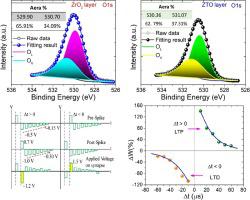当前位置:
X-MOL 学术
›
Appl. Surf. Sci.
›
论文详情
Our official English website, www.x-mol.net, welcomes your
feedback! (Note: you will need to create a separate account there.)
Controllable analog resistive switching and synaptic characteristics in ZrO2/ZTO bilayer memrsitive device for neuromorphic systems
Applied Surface Science ( IF 6.3 ) Pub Date : 2020-11-01 , DOI: 10.1016/j.apsusc.2020.147107 Muhammad Ismail , Haider Abbas , Changhwan Choi , Sungjun Kim
Applied Surface Science ( IF 6.3 ) Pub Date : 2020-11-01 , DOI: 10.1016/j.apsusc.2020.147107 Muhammad Ismail , Haider Abbas , Changhwan Choi , Sungjun Kim

|
Abstract The development of artificial synaptic devices is a crucial step for the realization of efficient bio-inspired neuromorphic computing systems. In this work, the bilayer ZrO2/ZTO-based electronic synaptic devices were fabricated for better emulation of the brain’s functions for neuromorphic computing. The ZrO2/ZTO switching layer is used to achieve stable and continuous switching for the emulation of the synaptic functions. The growth and rupture of conducting filament can be efficiently controlled by modulating the SET-compliance current (CC, 1 mA to 10 mA with 0.5 mA increment) and the RESET-voltage (1.0 V to 2.0 V, with 0.025 V increment) during the SET- and RESET-process, respectively. The incremental switching characteristics were exploited with proper pulse stimulations to emulate essential synaptic functions. Various pulse measurements were carried out to mimic some of the basic synaptic functions including long-term potentiation (LTP), long-term depression (LTD), spike-rate-dependent plasticity (SRDP), paired-pulse facilitation (PPF), and post-tetanic potentiation (PTP). Finally, the spike-timing-dependent plasticity (STDP) learning behavior was successfully emulated, which demonstrates the feasibility of ZrO2/ZTO-based electronic synaptic device for neuromorphic applications.
中文翻译:

用于神经形态系统的 ZrO2/ZTO 双层忆阻器件中的可控模拟电阻开关和突触特性
摘要 人工突触设备的开发是实现高效仿生神经形态计算系统的关键一步。在这项工作中,制造了基于双层 ZrO2/ZTO 的电子突触装置,以更好地模拟大脑的神经形态计算功能。ZrO2/ZTO 开关层用于实现稳定和连续的开关以模拟突触功能。导电丝的生长和断裂可以通过调节 SET 合规电流(CC,1 mA 至 10 mA,增量为 0.5 mA)和 RESET 电压(1.0 V 至 2.0 V,增量为 0.025 V)来有效控制。 SET- 和 RESET- 过程,分别。通过适当的脉冲刺激利用增量切换特性来模拟基本的突触功能。进行了各种脉冲测量以模拟一些基本的突触功能,包括长时程增强 (LTP)、长时程抑制 (LTD)、尖峰率依赖性可塑性 (SRDP)、成对脉冲易化 (PPF) 和强直后增强 (PTP)。最后,成功模拟了脉冲时间依赖性可塑性 (STDP) 学习行为,这证明了基于 ZrO2/ZTO 的电子突触装置在神经形态应用中的可行性。
更新日期:2020-11-01
中文翻译:

用于神经形态系统的 ZrO2/ZTO 双层忆阻器件中的可控模拟电阻开关和突触特性
摘要 人工突触设备的开发是实现高效仿生神经形态计算系统的关键一步。在这项工作中,制造了基于双层 ZrO2/ZTO 的电子突触装置,以更好地模拟大脑的神经形态计算功能。ZrO2/ZTO 开关层用于实现稳定和连续的开关以模拟突触功能。导电丝的生长和断裂可以通过调节 SET 合规电流(CC,1 mA 至 10 mA,增量为 0.5 mA)和 RESET 电压(1.0 V 至 2.0 V,增量为 0.025 V)来有效控制。 SET- 和 RESET- 过程,分别。通过适当的脉冲刺激利用增量切换特性来模拟基本的突触功能。进行了各种脉冲测量以模拟一些基本的突触功能,包括长时程增强 (LTP)、长时程抑制 (LTD)、尖峰率依赖性可塑性 (SRDP)、成对脉冲易化 (PPF) 和强直后增强 (PTP)。最后,成功模拟了脉冲时间依赖性可塑性 (STDP) 学习行为,这证明了基于 ZrO2/ZTO 的电子突触装置在神经形态应用中的可行性。











































 京公网安备 11010802027423号
京公网安备 11010802027423号